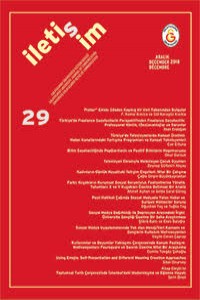Kullanımlar ve Doyumlar Yaklaşımı Çerçevesinde Konum Paylaşım Motivasyonları: Foursquare ve Swarm Üzerine Nitel Bir Araştırma
Abstract
Günümüzde tüm sosyal ağlarda konum verisi
paylaşılabiliyorken bile Foursquare ve Swarm’da ortalama günlük check-in sayısı
9 milyonu aşmaktadır. Bu çalışmada konum tabanlı sosyal ağ kullanıcılarının
konum paylaşma motivasyonlarını ortaya koymak amaçlanmıştır. Çalışmada
Kullanımlar ve Doyumlar Yaklaşımı çerçevesinde nitel bir araştırma yapılmış,
veri toplama tekniği olarak derinlemesine görüşme kullanılmıştır. Katılımcılar
hem Foursquare hem Swarm kullanan 10 kullanıcıdan oluşmaktadır. Araştırmada
belirlenen kullanım motivasyonları şunlardır: mekân tercihlerinde KTSA’nın
işlevselliği; gidilen yeri kayıt altına alma isteği; paylaşılan mekân üzerinden
kimlik sunumu; sosyalleşme; mayorlık aracılığıyla mekânla kurulan aidiyet ve
sahiplik ilişkisi; ve KTSA’daki oyunsal unsurlar.
References
- Burnett, R. (2012). İmgeler Nasıl Düşünür? (G. Pusar, Çev.) İstanbul: Metis. de Souza e Silva, A., & Frith, J. (2010). Locative Mobile Social Networks: Mapping Communication and Location in Urban Spaces. Mobilities , 5 (4), 485-505.
- Dourish, P., & Bell, G. (2011). Divining A Digital Futura: Mess And Mythology In Ubiquitous Computing. London: MIT.
- Evans, L. (2015). Locative Social Media: Place in the Digital Age. Basingstoke and New York: Palgrave Macmillan.
- Farman, J. (2014). Creative Misuse as Resistance: Surveillance, Mobile Technologies, and Locative Games . Surveillance & Society , 12 (3), 377-388. Foursquare. (2018). Foursquare. 03 08, 2018 tarihinde About: https://tr.foursquare.com/about adresinden alındı
- Frith, J. (2015). Smartphones as Locative Media. Cambridge: Polity.
- Frith, J. (2013). Turning Life Into A Game: Foursquare, Gamification, and Personal Mobility. Mobile Media & Communication , 1 (2), 248-262.
- Göregenli, M. (2015). Çevre Psikolojisi: İnsan-Mekân İlişkileri. İstanbul: Bilgi Üniversitesi Yayınları.
- Galloway, A. (2008). A Brief History of the Future of Urban Computing and Locative Media (Doktora Tezi) . Ontario: Carleton University.
- Gazzard, A. (2011). Location, Location, Location: Collecting Space and Place in Mobile Media. Convergence , 17 (4), 405-417.
- Goffman, E. (2004). Gündelik Yaşamda Benliğin Sunumu. İstanbul: Metis. Hjorth, L., & de Souza e Silva, A. (2009). Playful Urban Spaces: A Historical Approach To Mobile Games. Simulation & Gaming , 1-24.
- Hjorth, L., & Richardson, I. (2017). Pokémon Go: Mobile Media Play, Place-Making, and the Digital Wayfarer. Mobile MEdia & Communication , 3-14.
- Humphreys, L. (2010). Mobile Social Networks And Urban Public Space . New Media & Society , 763-778 .
- Katz, E., Blumer, J. G., & Gurevitch, M. (1973). Uses and Gratifications Reserach. The Public Opinion Quarterly , 37 (4), 509-523.
- McGonigal, J. (2011). Reality is Broken. New York: The Penguin Press.
- Montola, M., Waern, A., & Stenros, J. (2009). Pervasive Games:Experiences on the Boundary Between Life and Play. USA: Elsevier.
- Nguyen, P. T. (2017). "Nostalgic for the present": Digital Nostalgia and MEdiated Authenticity on Instagram. Stockholm University.
- Özçetin, B. (2010). “Kullanımlar ve Doyumlar”dan İzlerkitle Sosyolojisine: Türkiye’de İzlerkitle Çalışmaları . İletişim : Araştırmaları , 8 (2), 9-37.
- Özkul, D. (2014). Mobile NodesMobile and Locative Media, Everyday Life and Sense of Place PhD (Doktora Tezi). London: Unversity of Westminster.
- Rheingold, H. (2002). Smart Mobs: The Next Social Revolution. Cambridge: Perseus.
- Schwartz, R. (2015). Online Place Attachment: Exploring Technological Ties To Physical Places. A. de Souza e Silva, & M. Sheller içinde, Mobility and Locative Media: Mobile Communication in Hybrid Spaces (s. 85-100). NewYork: Routledge.
- Sutko, D., & de Souza e Silva, A. (2010). Location-Aware Mobile Media and Urban Sociability. New Media & Society , 13 (5), 807-823.
- Sutko, D., & de Souza e Silva, A. (2011). Location-Aware Mobile Media and Urban Sociability. New Media & Society , 807-823.
- Tokgöz, C. (2017). Konum Tabanlı Mobil Oyunlar ve Mekân Algısı: Ingress Üzerine Etnografik Bir Araştırma. İLEF Dergisi , 4 (2), 7-36.
- Tokgöz, C. (2018). Mekân ve Beden Bağlamında Gözetim ve Direniş. Kültür ve İletişim Dergisi , 21 (41), 60-83.
- Wilken, R. (2012). Locative Media: From Specialized Preoccupation To Mainstream Fascination. Convergence: The International Journal Of Research Into New Media Technologies , 18 (3), 243-247.
Details
| Primary Language | Turkish |
|---|---|
| Journal Section | Research Article |
| Authors | |
| Publication Date | December 25, 2018 |
| Published in Issue | Year 2018 Issue: 29 |



